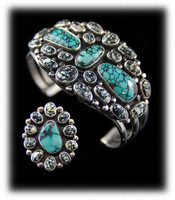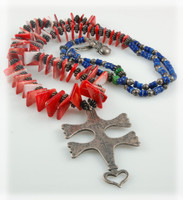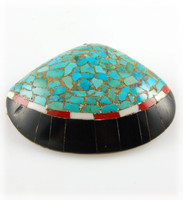 Loading... Please wait...
Loading... Please wait...- 970-759-1040 Text / Voice
- My Account
Currency Displayed in
Categories
Turquoise Jewelry
Posted by John Hartman on May 2nd 2016
Turquoise Jewelry
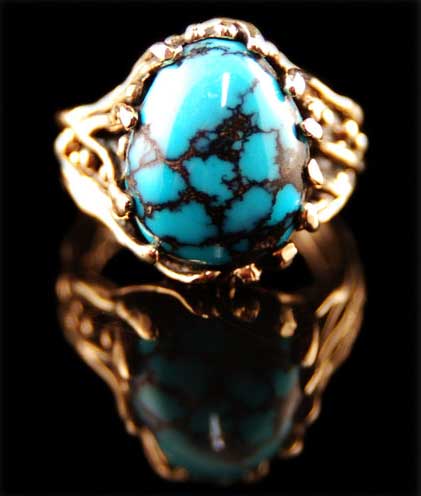
Jewelry with the use of Turquoise has been made for over 7,500 years; this fact is from Archeology records. We know that when ancient peoples originally found Turquoise, they believed it to be sent from the gods above and it was used for spiritual and medicinal purposes. With this being said, adornments (forms of Jewelry) for tombs, burials and ceremonial pieces could have been made hundreds or even thousands of years prior to 6,000 B.C.
It is certain that self adornment in the form of Turquoise Jewelry started in what we now know as Egypt. Turquoise was later discovered in Persia around 3-4000 B.C. and nomadic traders traded it to distant places throughout the old world until relatively recent years.
Turquoise was discovered in the New World (North America, ), around 800 A.D by Native American Indians. Archeology records show that they too first believed the stone was sacred and used for ceremonial and medicinal purposes as well. The first form of Turquoise Jewelry in America was found at the Chaco Ruins (in northern New Mexico) from about 1200A.D. Turquoise Beads were made to be worn as self adornment for the Native Americans.
In the mid 19th century, a Navajo Indian named Atsidi Sani learned how to work silver from the Spaniards. In, approximately 1880, Atsidi and well as other Navajo Indians were incorporating Turquoise into their Jewelry. Indian Traders quickly realized value in Navajo Jewelry and began trading and making a market for it. Early tourists on the Railroad and visitors to the Grand Canyon adored Indian Jewelry and it became the favored souvenir to bring home from their holiday. Along with the popularity of the Grand Canyon and the increase in tourism do to the automobile, Turquoise Jewelry became an industry for the Navajo Indians and their associates.
By the 1930’s, Indian Jewelry had been adopted by all of the National Parks in the western United States. The Turquoise Jewelry industry has enjoyed a brisk and continuing increase in business since. Today, it is seen frequently worn on Movie Stars, in Magazines and in specialty shops & galleries around the country.
Southwest styled Jewelry is predominately made by the Navajo Indians, Zuni Indians, Contemporary (Anglo & Hispanic) Artists and Jewelry Manufacturers throughout Arizona, New Mexico and Colorado.
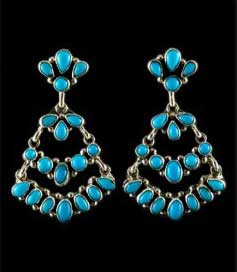
Navajo Indian Jewelry generally has much attention to the craftsmanship of the silver accented with Turquoise Cabochons. Often, heavy stamping and intricate embellishments made of multiple layers of silver make Navajo Jewelry unique into itself.
Zuni Indian Jewelry has always had the emphasis on stonework. The silver is simplistic and intended to be the foundation for their fine attention inlaying multiple stones into the silver and/or using tiny individual stones in patterned designs called needlepoint or petty point. Needlepoint is tiny stones in the shape of a needle and petty point is tiny round stones. The Jewelers use many stones in a unique design to create their pieces which are very creative and desirable.
Hopi Indian Jewelry, until recent years, did not use Turquoise or any other gemstone in their design. They design their pieces with an overlay technique, first they cut the design out of a sheet of silver, then they overlay it onto another sheet of silver by laminating the two sheets of silver together. The designs are usually geometric or pictorial and very intricate.
Southwest Hispanic Jewelers tend to follow the Navajo style of Jewelry design. They often incorporate a lot of tooling on the silver and accent their pieces with gemstones. Hispanic peoples have had a great history of Jewelry making in the Southwest, however, the craft goes back several hundred years in the history of Mexico. Mexicans are known throughout the world for being some of the finest silver workers on earth.
Southwest Anglo Silversmiths create what is called contemporary Jewelry. Their pieces are usually in vogue with the latest styles in the media. They are often responsible for coming up with the new design trends. Historically, this has been the case; Anglo Indian Traders would take the Jewelry to market and have the interaction with the buyers resulting in developing the new designs to meet the demands of the public.
Today, American Indians, Anglos and Hispanics work together in harmony to create some of the most unique Jewelry on this planet. Modern combined techniques and tools allow Jewelers of the Southwest to create Jewelry designs that are not only unique, some are dynamic.
As the media has gone global, Southwest Jewelry design has become the envy of the world. Jewelry makers and manufacturers in many areas of the world are now incorporating Southwest designs into their own Jewelry. You can expect to see Turquoise Jewelry from many areas of the world today as Turquoise has come into its own and is beloved by people throughout the world.
Durango Silver Company of Durango Colorado has been in the Turquoise Jewelry business for nearly 40 years now. Our focus has always been the highest quality gemstones accompanied with unique designs made by Native American Craftsmen. We specialize in “one of a kind” Southwest Jewelry items of unquestionable quality and we guarantee its authenticity. We invite you to look at our fine pieces and hope that you will come back often to see our new creations as they are made. Remember, each Natural Gem Quality Turquoise Stone is absolutely unique to itself – It is a “One of a Kind”.




